91-95-2
| Name | 3,3'-Diaminobenzidine |
|---|---|
| Synonyms |
EINECS 202-110-6
[1,1'-Biphenyl]-3,3',4,4'-tetramine Biphenyl-3,3',4,4'-tetramine MFCD00007725 3,3',4,4'-Biphenyltetramine 4-(3,4-diaminophenyl)benzene-1,2-diamine (1,1'-Biphenyl)-3,3',4,4'-tetramine 3,3'-diaminobenzidine |
| Description | [1,1'-Biphenyl]-3,3',4,4'-tetraamine is a biochemical reagent that can be used as a biological material or organic compound for life science related research. |
|---|---|
| Related Catalog |
| Density | 1.3±0.1 g/cm3 |
|---|---|
| Boiling Point | 481.7±45.0 °C at 760 mmHg |
| Melting Point | 175-177 °C(lit.) |
| Molecular Formula | C12H14N4 |
| Molecular Weight | 214.266 |
| Flash Point | 282.7±25.6 °C |
| Exact Mass | 214.121841 |
| PSA | 104.08000 |
| LogP | -0.76 |
| Vapour Pressure | 0.0±1.2 mmHg at 25°C |
| Index of Refraction | 1.766 |
| Stability | Stability Moisture and light sensitive. Incompatible with strong oxidizing agents. |
| Water Solubility | 0.55 g/L (20 ºC) |
Synonym:3,3',4,4'-Biphenyltetramine; 3,3',4,4'-Tetraaminobiphenyl Section 2 - COMPOSITION, INFORMATION ON INGREDIENTS
Risk Phrases: 22 36/37/38 40 Section 3 - HAZARDS IDENTIFICATION EMERGENCY OVERVIEW
Harmful if swallowed. Irritating to eyes, respiratory system and skin. Limited evidence of a carcinogenic effect.Light sensitive.Hygroscopic (absorbs moisture from the air). Potential Health Effects Eye: Causes eye irritation. May cause chemical conjunctivitis. Skin: Causes irritation with burning pain, itching, and redness. Ingestion: May cause gastrointestinal irritation with nausea, vomiting and diarrhea. The toxicological properties of this substance have not been fully investigated. May be harmful if swallowed. Inhalation: May cause cyanosis (bluish discoloration of skin due to deficient oxygenation of the blood). Causes respiratory tract irritation. The toxicological properties of this substance have not been fully investigated. Can produce delayed pulmonary edema. Chronic: Effects may be delayed. Section 4 - FIRST AID MEASURES Eyes: Immediately flush eyes with plenty of water for at least 15 minutes, occasionally lifting the upper and lower eyelids. Get medical aid. Skin: Get medical aid. Flush skin with plenty of water for at least 15 minutes while removing contaminated clothing and shoes. Wash clothing before reuse. Ingestion: Never give anything by mouth to an unconscious person. Get medical aid. Do NOT induce vomiting. If conscious and alert, rinse mouth and drink 2-4 cupfuls of milk or water. Inhalation: Remove from exposure and move to fresh air immediately. If not breathing, give artificial respiration. If breathing is difficult, give oxygen. Get medical aid. Do NOT use mouth-to-mouth resuscitation. Notes to Physician: Treat symptomatically and supportively. Antidote: None reported. Section 5 - FIRE FIGHTING MEASURES General Information: As in any fire, wear a self-contained breathing apparatus in pressure-demand, MSHA/NIOSH (approved or equivalent), and full protective gear. During a fire, irritating and highly toxic gases may be generated by thermal decomposition or combustion. Extinguishing Media: Use water spray, dry chemical, carbon dioxide, or appropriate foam. Section 6 - ACCIDENTAL RELEASE MEASURES General Information: Use proper personal protective equipment as indicated in Section 8. Spills/Leaks: Clean up spills immediately, observing precautions in the Protective Equipment section. Sweep up or absorb material, then place into a suitable clean, dry, closed container for disposal. Avoid generating dusty conditions. Provide ventilation. Section 7 - HANDLING and STORAGE Handling: Wash thoroughly after handling. Remove contaminated clothing and wash before reuse. Use with adequate ventilation. Minimize dust generation and accumulation. Avoid contact with eyes, skin, and clothing. Keep container tightly closed. Avoid ingestion and inhalation. Store protected from light. Storage: Store in a tightly closed container. Store in a cool, dry, well-ventilated area away from incompatible substances. Store protected from moisture. Store protected from light. Section 8 - EXPOSURE CONTROLS, PERSONAL PROTECTION Engineering Controls: Facilities storing or utilizing this material should be equipped with an eyewash facility and a safety shower. Use adequate ventilation to keep airborne concentrations low. Exposure Limits CAS# 91-95-2: United States OSHA: (Cancer suspect agent - see 29 CFR 1910.1010) (listed under Benzidine). France - VME: (listed as benzidine): 0.001 ppm VME; 0.008 mg/m3 V Germany: 0.003 ppm TWA; 0.03 mg/m3 TWA (inhalable fraction) Germany: Skin absorber Personal Protective Equipment Eyes: Wear appropriate protective eyeglasses or chemical safety goggles as described by OSHA's eye and face protection regulations in 29 CFR 1910.133 or European Standard EN166. Skin: Wear appropriate protective gloves to prevent skin exposure. Clothing: Wear appropriate protective clothing to prevent skin exposure. Respirators: Follow the OSHA respirator regulations found in 29 CFR 1910.134 or European Standard EN 149. Use a NIOSH/MSHA or European Standard EN 149 approved respirator if exposure limits are exceeded or if irritation or other symptoms are experienced. Section 9 - PHYSICAL AND CHEMICAL PROPERTIES Physical State: Crystalline powder Color: brown Odor: odorless pH: 7 (1g/l aq. soln.) Vapor Pressure: Not available. Viscosity: Not available. Boiling Point: Not available. Freezing/Melting Point: 176.00 - 180.00 deg C Autoignition Temperature: Not applicable. Flash Point: Not applicable. Explosion Limits, lower: N/A Explosion Limits, upper: N/A Decomposition Temperature: > 400 deg C Solubility in water: 0.55 g/l (20 c) Specific Gravity/Density: Molecular Formula: C12H14N4 Molecular Weight: 214.27 Section 10 - STABILITY AND REACTIVITY Chemical Stability: Stable under normal temperatures and pressures. Light sensitive. Hygroscopic: absorbs moisture or water from the air. Conditions to Avoid: Incompatible materials, light, dust generation, excess heat, exposure to moist air or water. Incompatibilities with Other Materials: Oxidizing agents. Hazardous Decomposition Products: Nitrogen oxides, carbon monoxide, carbon dioxide, ammonia. Hazardous Polymerization: Will not occur. Section 11 - TOXICOLOGICAL INFORMATION RTECS#: CAS# 91-95-2: DV8750000 LD50/LC50: CAS# 91-95-2: Oral, mouse: LD50 = 1834 mg/kg. Carcinogenicity: 3,3'-Diaminobenzidine - California: carcinogen, initial date 2/27/87 (listed as Benzidine). NTP: Known carcinogen (listed as Benzidine). IARC: Group 1 carcinogen (listed as Benzidine). Other: See actual entry in RTECS for complete information. Section 12 - ECOLOGICAL INFORMATION Section 13 - DISPOSAL CONSIDERATIONS Dispose of in a manner consistent with federal, state, and local regulations. Section 14 - TRANSPORT INFORMATION IATA Shipping Name: Not regulated. Hazard Class: UN Number: Packing Group: IMO Shipping Name: Not regulated. Hazard Class: UN Number: Packing Group: RID/ADR Shipping Name: Not regulated. Hazard Class: UN Number: Packing group: Section 15 - REGULATORY INFORMATION European/International Regulations European Labeling in Accordance with EC Directives Hazard Symbols: XN Risk Phrases: R 22 Harmful if swallowed. R 36/37/38 Irritating to eyes, respiratory system and skin. R 40 Limited evidence of a carcinogenic effect. Safety Phrases: S 28A After contact with skin, wash immediately with plenty of water. S 37 Wear suitable gloves. S 45 In case of accident or if you feel unwell, seek medical advice immediately (show the label where possible). WGK (Water Danger/Protection) CAS# 91-95-2: 2 Canada CAS# 91-95-2 is listed on Canada's NDSL List. CAS# 91-95-2 is not listed on Canada's Ingredient Disclosure List. US FEDERAL TSCA CAS# 91-95-2 is listed on the TSCA inventory. SECTION 16 - ADDITIONAL INFORMATION N/A |
CHEMICAL IDENTIFICATION
HEALTH HAZARD DATAACUTE TOXICITY DATA
MUTATION DATA
|
| Symbol |


GHS07, GHS08 |
|---|---|
| Signal Word | Danger |
| Hazard Statements | H302-H319-H341-H350 |
| Precautionary Statements | P201-P280-P301 + P312 + P330-P305 + P351 + P338-P308 + P313-P337 + P313 |
| Personal Protective Equipment | dust mask type N95 (US);Eyeshields;Gloves |
| Hazard Codes | Xn:Harmful; |
| Risk Phrases | R22;R36/37/38;R40 |
| Safety Phrases | S26-S36/37-S45-S36/37/39 |
| RIDADR | NONH for all modes of transport |
| WGK Germany | 1 |
| RTECS | DV8750000 |
| HS Code | 2921590090 |
| Precursor 9 | |
|---|---|
| DownStream 5 | |
| HS Code | 2921590090 |
|---|---|
| Summary | 2921590090. other aromatic polyamines and their derivatives; salts thereof. VAT:17.0%. Tax rebate rate:13.0%. . MFN tariff:6.5%. General tariff:30.0% |


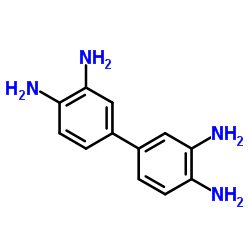
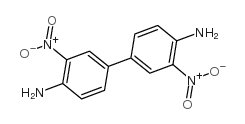

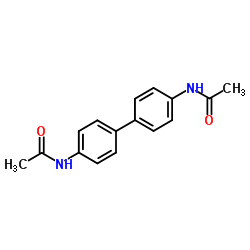

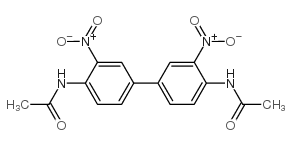
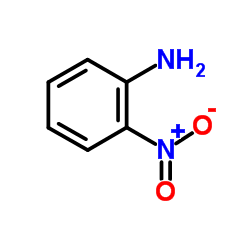

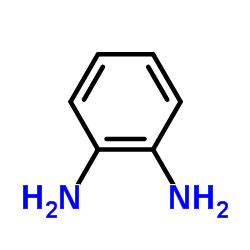

![6-[2,3-bis(4-bromophenyl)quinoxalin-6-yl]-2,3-bis(4-bromophenyl)quinoxaline structure](https://image.chemsrc.com/caspic/162/330441-57-1.png)

![4-[5-[2-(4-oxocyclohexa-2,5-dien-1-ylidene)-1,3-dihydrobenzimidazol-5-yl]-1,3-dihydrobenzimidazol-2-ylidene]cyclohexa-2,5-dien-1-one structure](https://image.chemsrc.com/caspic/079/137961-52-5.png)
![4-[2-(1H-benzimidazol-2-yl)-3H-benzimidazol-5-yl]benzene-1,2-diamine structure](https://image.chemsrc.com/caspic/132/862279-51-4.png)
![1H,1'H,1''H,1'''H-2,2':5',5'':2'',2'''-quaterbenzo[d]imidazole structure](https://image.chemsrc.com/caspic/170/862279-50-3.png)